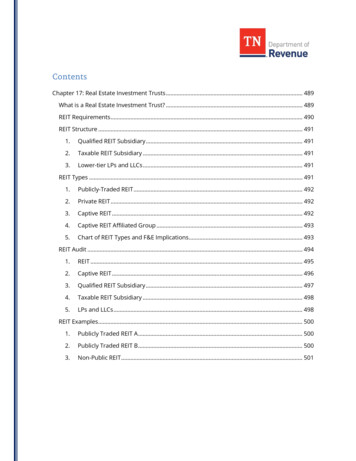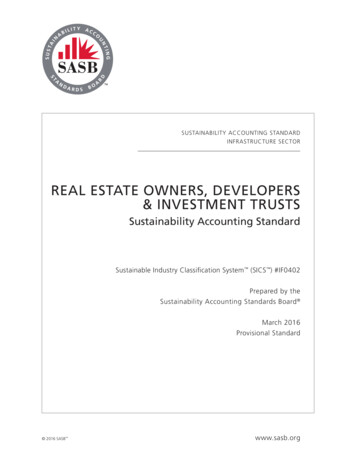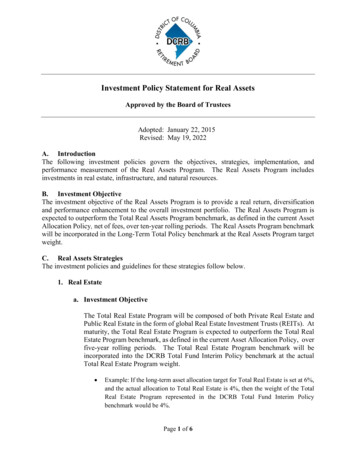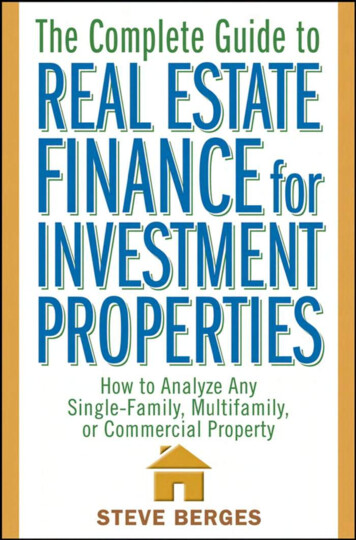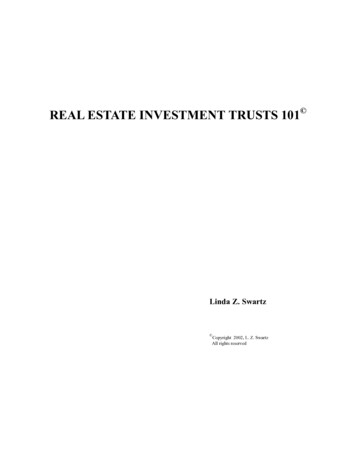
Transcription
REAL ESTATE INVESTMENT TRUSTS 101 Linda Z. Swartz Copyright 2002, L. Z. SwartzAll rights reserved
REAL ESTATE INVESTMENT TRUSTS 101TABLE OF CONTENTSPageI.INTRODUCTION . 1II.QUALIFICATION REQUIREMENTS. 1A.B.C.D.III.Structure. 11.Form. . 12.Management. . 13.Ownership. . 24.Tax Year. 3Asset Composition . 31.Real Estate and Low-Risk Assets. . 32.Diversification Requirement. . 53.QRS Look-Through Rule. . 64.Partnership Look-Through Rule. . 6Income Requirements. 71.75% Test. 72.95% Test. 83.Considerations in Applying Income Tests. . 84.Income-Based Rents and Interests. 95.Rent from Related Tenants. 106.Impermissible Tenant Service Income. 107.Independent Contractor. 11Distribution Requirements. 121.90% Test. 122.Accumulated E&P. . 12TAXES IMPOSED . 13A.REIT Taxable Income . 131.Regular Corporate Tax. 132.Net Capital Gain. . 13
iiPageB.C.D.E.F.G.H.IV.Treatment of REIT Shareholders . 131.Dividend Treatment. . 132.Capital Gains. . 14Income from Foreclosure Property . 141.Tax. . 142.Calculation. 14Income Test Deficiencies . 151.Tax. . 152.Amount of Tax. 15Excise Tax. 151.Distribution Requirement. 152.Amount Taxed. . 15Prohibited Transactions . 161.Tax. . 162.Safe Harbor. 16Reallocations of Rents, Deductions and Interest. 171.Tax. . 172.Redetermined Rents. . 173.Redetermined Deductions. . 174.Excessive Interest. . 18Failure to Determine Beneficial Ownership . 181.Requirement. . 182.Penalty. 18HOT ISSUES. 18A.Taxable REIT Subsidiaries . 181.Background. . 182.Conversion of PSS to TRS. . 183.Definition of TRS. . 194.Activities of TRS. . 195.Ensuring Taxation of TRS Earnings. . 20
iiiPageB.C.D.Satisfying Distribution Requirements with Stock. 201.Section 305(b). 202.Examples. . 20Conversions and Asset Transfers from C Corporations . 211.Notice 88-19. . 212.New Regulations. 213.Accumulated E&P. . 224.Conversion to QRS. . 22UPREITs. 221.Form. . 222.Operation. . 23
REAL ESTATE INVESTMENT TRUSTS 101I.INTRODUCTIONThe real estate investment trust (REIT) was originally intended to be a mutual fund forreal estate. The original REIT legislation, enacted in 1960, was intended to provide a taxfavored vehicle through which the average person could invest in a professionallymanaged portfolio of real property. The complex rules governing REITs are all meant tofurther this intent: that a REIT remains predominantly a real estate entity, that its realestate is professionally managed, that the REIT itself (and thus its investors) avoids therisks of conducting an active business, and that the fruits of the investments are regularlydistributed to the investors.1 The reward for compliance is exemption from federalincome taxes at the REIT level. Contrary to the purposes of the original legislation,REITS are now active business entities that compete with taxable corporations andexpose their shareholders to business risk.2 This outline examines the rules governing thequalification and taxation of REITS, and notable issues that have been addressed bymodern REITs.II.QUALIFICATION REQUIREMENTSA.Structure1.2.Form. Throughout the taxable year, a REIT must:·be a corporation, trust or association;·be otherwise taxable as a domestic corporation;·not be a financial institution under section 582(c)(2);·not be an insurance company under subchapter L; and·file with its return an election to be treated as a REIT (or, if it haspreviously made an election, the election must not have beenterminated or revoked under section 856(g).Management. Throughout the taxable year, a REIT must be managed by1 or more trustees or directors.1See Steven F. Mount, Real Estate Investment Trusts, 742 Tax Mngt. Port. A-1 (BNA 2000).2See David M. Einhorn, Unintended Advantage: Equity REITs vs. Taxable Real Estate Companies, 51Tax Lawyer 203.
23.Ownership.···Throughout the taxable year, ownership must be evidenced bytransferable shares or transferable certificates of beneficial interest.·Provisions in a trust instrument or corporate charter or bylaws that permit the trustee or directors to refuse to transfershares where the trustee or directors believe in good faiththat a transfer would result in the loss of REIT status doesnot render the shares “nontransferable.”3·The IRS has ruled that an “excess share” provision in theREIT’s governing instrument designed to prevent violationof the closely-held prohibition (see below) will not causethe shares to be nontransferable.4Beneficial ownership must be held by 100 or more persons at least335 days of every taxable year or a proportionate part of a tax yearless than 12 months.·Beneficial ownership is determined without reference toany attribution rules.5·This requirement is waived for the first year of a REITelection. 6A REIT must not be closely held, i.e., an entity will be disqualifiedas a REIT if more than 50% of the value of its shares is owneddirectly or indirectly by or for five or fewer individuals at any timeduring the last half of the REIT’s taxable year (the “5/50 test”).7·This requirement is waived for the first year after a REITelection. 83Treas. Reg. § 1.856-1(d)(2).4Priv. Ltr. Rul. 8921067 (Feb. 28, 1989). The provision considered in the ruling was an amendment tothe articles of incorporation that would prohibit any transfer that would cause a transferee to ownmore than 3.9 percent in value of all of the outstanding stock of the REIT. Excess Shares aregenerally a separate class of common shares that have no voting or distribution rights; Sharestransferred to a party contrary to a REIT’s articles are transformed by operation of law into ExcessShares held in trust for the benefit of the transferee. Upon a permitted transfer of the shares, theytransform into common shares.5Treas. Reg. § 1.856-1(d)(2).6I.R.C. § 856(h)(2).7I.R.C. §§ 856(h)(1), 542(a)(2).8I.R.C. § 856(h)(2).
3·For purposes of this requirement, stock attribution rules ofsection 544 apply, but without attribution among partners.9·4.B.Thus, substantially all of the shares of a REIT canbe owned by a corporate sponsor such a REIT, a“captive REIT”). The 5/50 test and the 100beneficial owners requirement would both besatisfied if, for example, the corporate sponsor has10 equal shareholders and the remaining shares ofthe REIT are owned by 99 employees of thecorporate sponsor.·For purposes of this requirement, stock owned by a taxexempt 401(a) plan is deemed to be owned by planbeneficiaries.10·A REIT that complies with regulations prescribing methodsof ascertaining actual and beneficial ownership may avoiddisqualification if it reasonably does not know that it failedto satisfy the 5/50 test.11·An entity that runs afoul of the 5/50 test would bedisqualified as a REIT and taxed as a personal holdingcompany.12Tax Year. An entity making the REIT election in any taxable yearbeginning after October 4, 1976 must adopt the calendar year as its taxableyear, and may not change its taxable year as long as the REIT election isin effect.13Asset Composition1.Real Estate and Low-Risk Assets. At the close of each quarter of thetaxable year,14 at least 75% of a REIT’s assets must consist of:9I.R.C. § 856(h)(1).10I.R.C. § 856(h)(3).11I.R.C. § 856(k).12Treas. Reg. § 1.856-1(d)(5).13I.R.C. § 859(a).14Failure to satisfy the asset test at a quarter end will not cause a disqualification if the asset test issatisfied at the close of the preceding quarter and either (i) the discrepancy between the value of theREIT’s assets and the asset test requirements arose from changes in the market value of its assets andwas not caused by acquisition of one or more nonqualifying assets, or (ii) the discrepancy iseliminated within 30 days after the close of the quarter in which it arose. I.R.C. § 856(c)(4)(B).
4·interests in real property, including interests in mortgages on realproperty;15·“mortgages on real property” include deeds of trust on realproperty;16·“interests in real property” include foreign real propertyand security interests in foreign real property that arelegally equivalent to U.S. mortgages or deeds of trust.17·shares (or certificates of beneficial interest in) other REITS;18·for a 1-year period after the REIT receives “new capital,” anystock or debt instrument attributable to a temporary investment ofthe new capital, defined as amounts received either:··in exchange for stock of the REIT, or·in a public debt offering in exchange for debt havingmaturities of at least 5 years;19interests in REMICs;··if less than 95% of REMIC assets are composed of realestate assets (assets described in a. through d. herein, testedas if the REIT held the assets directly), the REIT is treatedas holding directly its proportionate shares of REMICassets.20cash and cash items;·cash items include certificates of deposit and ordinaryreceivables arising from the ordinary operation of theREIT, but not purchased receivables;21·repo agreements in which a REIT “purchases” Treasurynotes to be “sold” back to a bank are not cash items.2215I.R.C. § 856(c)(5)(B);16Treas. Reg. § 1.856-3(b)(1).17Rev. Rul. 74-191, 1974-1 C.B. 170.18I.R.C. § 856(c)(5)(B).19I.R.C. § 856(c)(5)(D)(ii).20I.R.C. § 856(c)(5)(E).21Treas. Reg. § 1.856-2(d)(1).22Rev. Rul. 77-59, 1977-1 C.B. 196.
5·2.U.S. government securities.·As with all terms not defined in section 856(c)(5), themeaning of this term has the same meaning as used in theInvestment Company Act of 1940 (the “1940 Act”).23Under the 1940 Act, “security” generally includes any note,stock, bond or evidence of indebtedness.24·The IRS has provided in revenue rulings that “governmentsecurities” in this context include securities of the FederalHousing Administration, Federal National MortgageAssociation, Federal Home Bank, Federal Land Bank,Federal Intermediate Credit Bank, Banks for Cooperatives,Public Housing Administration, U.S. Postal Service,Commodity Credit Corporation, Small BusinessAdministration, and General Services Administration.25 Inaddition, the IRS has ruled in the context of RICs that“government securities” include obligations of the StudentLoan Marketing Association (Sallie Mae).26Diversification Requirement.··Securities (other than those described in 1. above) must account forno more than 25% of the value of a REIT’s total assets.·Note that a REIT that satisfies the 75% test described abovewill also satisfy this requirement.·Stock in other REITs and REMIC interests that qualify asreal estate assets, are excluded for purposes of thediversification requirement.·“Value” is generally defined as fair market value, but thevalue of stock in another REIT is the greater of the stockvalue or the value of the underlying assets. 27Beginning in 2001, securities of a taxable REIT subsidiary (a“TRS”) must account for no more than 20% of the value of aREIT’s total assets in the aggregate.23See I.R.C. § 856(c)(5)(F).2415 U.S.C. § 80(a)-2(a)(36).25Rev. Rul. 64-85, 1964-1 C.B. 230; Rev. Rul. 71-537, 1971-2 C.B. 262; G.C.M. 34648 (Oct. 19,1971); Rev. Rul. 74-440, 1974-2 C.B. 19; Rev. Rul. 76-426, 1976-2 C.B. 17; Rev. Rul. 77-342, 19772 C.B. 238; G.C.M. 36522 (Dec. 17, 1975).26Rev. Rul. 73-548, 1973-2 C.B. 14.27I.R.C. § 856(c)(5)(A).
6·3.Except with respect to securities of a TRS and securities describedin 1. above, securities of any 1 issuer must not account fori.more than 5% of the value of the REIT’s total assets,ii.more than 10% of the total voting power of the outstandingsecurities of the issuer, andiii.beginning in 2001, more than 10% of the total value of theoutstanding securities of the issuer.28·Safe harbor for straight debt. Straight debt29 is excludedfor purposes of this test if:the issuer is an individual,·the REIT and its TRSs, if any, hold only straightdebt of the issuer, or·the issuer is a partnership in which the REIT holds a20% or greater profits interest.QRS Look-Through Rule. The existence of a qualified REIT subsidiary(“QRS”) is disregarded.30 Accordingly, its assets, liabilities, and items ofincome, deduction and credit are deemed to be those of its parent REIT.·4.·A QRS is a corporation wholly owned by a REIT as towhich a TRS election is not in effect.31Partnership Look-Through Rule. A REIT that is a partner in apartnership is deemed to own its proportionate share of each of the assetsof the partnership, determined in accordance with capital interests(notwithstanding different allocations under section 704).32 It is unclearhow guaranteed payments are treated.28For taxable years beginning before Jan. 1, 2001, the diversification requirement was satisfied bycomplying with a. and c.1. above, and the requirement that the REIT hold no more than 10 percent ofthe outstanding voting securities of any issuer. The addition of b. and c.iii. above reinforces thestatutory TRS regime that is meant to limit a REIT’s use of nonvoting preferred stock subsidiaries toperform prohibited transactions.29As defined in section 1361(c)(5) without regard to section 1361(c)(5)(B)(iii).30I.R.C. § 856(i)(1).31I.R.C. § 856(i)(2).32Treas. Reg. § 1.856-3(g).
7C.Income Requirements1.75% Test. At least 75% of a REIT’s gross income for each taxable yearmust be composed of:·interest on obligations secured by mortgages on real property orinterests in real property;·rents from real property, including·rents from interests in real property·charges for services customarily rendered in connectionwith the rental of real property, whether or not such chargesare separately stated, and·rent attributable to personal property leased in connectionwith the lease of real property that does not exceed 15% ofthe total real and personal property rent from the lease forthe taxable year:·rent attributable to personal property with respect toa lease of real property is determined using theaverage of the fair market values at the beginningand end of the taxable year of the personal propertyand the real property;33·gain from the disposition of interests in real property (includinginterests in real property mortgages) that is not section 1221(a)(1)property (generally, property held primarily for sale in the courseof ordinary business);·abatements and refunds of real property taxes;·income and gain from “foreclosure property,” which is defined asany interest in real property and any personal property incident tothe real property that (i) is acquired by the REIT by bidding at aforeclosure, or otherwise acquired by agreement or legal processafter a default or imminent default on lease of such property or ondebt secured by such property, and (ii) is not property acquired as aresult of debt arising from the REIT’s disposition of section1221(a)(1) property; and as to which the REIT makes an election.3433I.R.C. § 856(d)(1).34This election is valid for 3 years after the taxable year in which the election is made, and may beextended for another 3 years with IRS approval, but will terminate if the REIT receives nonqualifyingincome from new construction or uses the property in a trade or business. I.R.C. § 856(e).
82.3.·consideration, other than amounts that depend on income or profitsof any person, received or accrued for entering into agreements to(i) make real property mortgage loans, or (ii) purchase or leaseinterests in real property (including interests in real propertymortgages);·gain from disposition of a real estate asset that is not a prohibitedtransaction (see section III.F. below);·distributions on, and gain from the disposition of, transferableshares in other REITs; and·qualified temporary investment income.95% Test. At least 95% of a REIT’s gross income for each taxable yearmust be composed of items that satisfy the 75% test and/or:·dividends;·interest;·gain from the disposition of stock and securities that are notsection 1221(a)(1) property; and·“hedging income.”35Considerations in Applying Income Tests.·Gross income for the 75% test and the 95% test does not includeincome from prohibited transactions.·COD recognized by a REIT is excluded from its gross income forpurposes of both the 75% test and the 95% test.36·QRS items of income are included as items of its REIT parent.·A REIT that is a partner in a partnership is deemed to receivepartnership income attributable to its share of partnership assetsdetermined in accordance with capital interests.37·A REIT that fails to satisfy either or both income tests due toreasonable cause and not willful neglect will not be disqualified aslong as the nature and amount of each item of gross incomedescribed in the 75% and 95% tests are set forth in a schedule35I.R.C. § 856(c)(5)(G).36I.R.C. § 108(e)(9).37Treas. Reg. § 1.856-3(g).
9attached to its tax return.38 However, the REIT will be subject to a100% tax on disqualifying income, as discussed in section III.D.below.4.Income-Based Rents and Interests··38I.R.C. § 856(c)(6).39I.R.C. § 856(d)(4).40I.R.C. § 856(d)(6).41I.R.C. § 856(f)(1)(B).42I.R.C. § 856(f)(2).“Rents from real property” does not include amounts that dependon the income or profits derived by any person from the property.·If a. above applies solely because the tenant of a REITreceives amounts from subtenants that depend on theincome or profits derived by any person from the property,only a proportionate part of the income is excluded.39·If a REIT receives amounts that depend on the income orprofits of a tenant that derives substantially all of its incomewith respect to the property from subleasing the property,and a portion of the amounts would be treated as “qualifiedrents” (i.e., rents from real property if received directly bythe REIT), the amount received by the REIT attributable tosuch qualified rent is included as rent from real property.40“Interest” does not include amounts that depend on the income orprofits derived by any person.·If b. above applies solely because the debtor of a REITreceives amounts from any person that depend on theincome or profits derived by any person, only aproportionate part of the income is excluded.41·If a REIT receives amounts on debt secured by a mortgageor interest in real property that depends on the income orprofits of a debtor deriving substantially all of its incomewith respect to the property from leasing the property, anda portion of the amounts would be treated as qualifiedrents, the amount received by the REIT attributable to suchqualified rent is included as interest.42
10·5.6.Rents from real property and interest include income or profitsbased on a fixed percentage or percentages of receipts or sales.43Rent from Related Tenants. “Rents from real property” does not includeamounts received from the following related persons:·Corporations in which the REIT owns 10% or more of the totalcombined voting power of all classes of stock entitled to vote, or10 percent or more of the total value44 of all shares, applyingmodified section 318 constructive ownership rules;·Non-corporate entities in which the REIT owns an interest of 10%of more of the assets or net profits, applying modified section 318constructive ownership rules.45·Rent received by a REIT from its TRS is treated as rent from realproperty where:i.at least 90 percent of the leased space of the property isrented to non-TRS tenants and persons not described in a.above, to the extent the rents paid by the TRS aresubstantially comparable to rents paid by other tenants forcomparable space, orii.the rent is paid for a non-gambling lodging facility leasedby the REIT to the TRS, and the property is operated onbehalf of the TRS by an “eligible independent contractor,”i.e., an independent contractor that, at the time it enters intoa service contract with the TRS, is actively engaged in thetrade or business of operating such facilities for any personwho is not related to the REIT or the TRS.46Impermissible Tenant Service Income. “Rents from real property” doesnot include “impermissible tenant service income” (“ITSI”),47 defined asamounts received (directly or indirectly) by a REIT for services renderedby the REIT to tenants, or for managing or operating the property, subjectto the following exceptions and special rules:43I.R.C. §§ 856(d)(2)(A), (f)(1)(A).44For taxable years beginning on or before December 31, 2000, the test applied to the number ratherthan value of all shares.45I.R.C. § 856(d)(2)(B), (d)(5).46I.R.C. § 856(d)(8), (9). These paragraphs relating to taxable REIT subsidiaries apply for taxableyears beginning after December 31, 2000.47I.R.C. § 856(d)(2)(C).
117.·services provided through a TRS or an independent contractorfrom whom the REIT does not derive any income are not treated asservices rendered by the REIT;·amounts that would be excluded from treatment as UBTI undersection 512(b)(3) if received by an exempt organization are notITSI;48·if amounts received by a REIT for services with respect to aproperty that are not excluded from ITSI treatment under a. or b.above exceed 1 percent of the income received (directly orindirectly) by the REIT with respect to the property, all amountsreceived by the REIT with respect to the property are treated asITSI;49 and·amounts received by a REIT for services are treated as being atleast equal to 150 percent of the REIT’s direct cost of providingthe services.50·Note that if a service is not customarily rendered in connectionwith the rental of real property, amounts received are excludedfrom rental income even if they fall under the exceptions describedabove.Independent Contractor. As used in sections 5. and 6. above, an“independent contractor” is any person that satisfies the following tests,applying certain constructive ownership rules of section 318:·The person does not own more than 35% of the interests in theREIT;·If the person is a corporation, not more than 35% of the totalcombined voting power of its stock (or 35% of the total shares ofits stock) is owned by one or more persons owning 35% or more ofthe interests in the REIT; and·If the person is not a corporation, no more than 35% of the interestin its assets or net profits is owned by one or more persons owning35% or more of the interests in the REIT.·Beginning with taxable years after 2000, for any class of stock ofthe REIT or the related person that is regularly traded on an48I.R.C. § 856(d)(7)(C).49I.R.C. § 856(d)(7)(B). Effective for tax years beginning after August 5, 1997. The 1% safe harborapplies on a property-by-property basis. Rev. Rul. 98-60, 1998-51 I.R.B. 6.50I.R.C. § 856(d)(7)(D).
12established securities market, only persons who own more than 5percent of such class is taken into account as owning any of thestock of such class for purposes of applying the 35% limit of b. andc. above.51D.Distribution Requirements1.90% Test. A REIT must distribute, and be eligible to take a dividendspaid deduction for, at least the difference between:·90%52 of the sum of (i) the REIT taxable income (excluding netcapital gains) for the taxable year before taking the dividends paiddeduction and (ii) the net income from foreclosure property, minusthe tax imposed on such foreclosure property income, and·excess noncash income, which is53 the sum of the amounts of fourcategories of noncash items, minus 5% of the REIT taxable incomedetermined without any net capital gain and before subtracting thedividends paid deduction.54 The four categories of noncash itemsare:·2.·the excess of Section 467 income (relating to certainpayments for the use of property or services) overother items of gross income,·gain from disqualified like-kind exchanges of realestate assets, if the REIT intended the exchange toqualify under section 1031 and the disqualificationwas due to reasonable cause,·the amount of OID and market discount accrued oninstruments to which sections 860E(a) or 1272apply, and·COD income.The calculation of income that must be distributed takesinto account items of phantom income that do not producedistributable cash.Accumulated E&P. If an entity was a corporation before electing to betreated as a REIT, the entity must distribute all of its accumulated earnings51I.R.C. § 856(d)(3).5295% for taxable years beginning on or before December 31, 2000.53I.R.C. § 857(a)(1).54I.R.C. § 857(e)(1).
13and profits (“E&P”) before the close of the taxable year in which it makesthe election.55 For taxable years beginning after August 5, 1997,distributions required under this rule are treated as made from the earliestof E&P that were accumulated in non-REIT years.56 This first-in, first-outrule facilitates the purging of non-REIT E&P from newly electing REITsduring the first taxable year of REIT status. How
REAL ESTATE INVESTMENT TRUSTS 101 I. INTRODUCTION The real estate investment trust (REIT)was originally intended to be a mutual fund for real estate. The original REIT legislation, enacted in 1960, was intended to provide a tax-favored vehicle through which the average person could invest in a professionally managed portfolio of real property.
